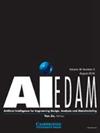Graph models for engineering design: Model encoding, and fidelity evaluation based on dataset and other sources of knowledge
IF 2.3
3区 工程技术
Q3 COMPUTER SCIENCE, ARTIFICIAL INTELLIGENCE
Ai Edam-Artificial Intelligence for Engineering Design Analysis and Manufacturing
Pub Date : 2023-02-20
DOI:10.1017/S0890060422000269
引用次数: 0
Abstract
Abstract Automatically extracting knowledge from small datasets with a valid causal ordering is a challenge for current state-of-the-art methods in machine learning. Extracting other type of knowledge is important but challenging for multiple engineering fields where data are scarce and difficult to collect. This research aims to address this problem by presenting a machine learning-based modeling framework leveraging the knowledge available in fundamental units of the variables recorded from data samples, to develop parsimonious, explainable, and graph-based simulation models during the early design stages. The developed approach is exemplified using an engineering design case study of a spherical body moving in a fluid. For the system of interest, two types of intricated models are generated by (1) using an automated selection of variables from datasets and (2) combining the automated extraction with supplementary knowledge about functions and dimensional homogeneity associated with the variables of the system. The effect of design, data, model, and simulation specifications on model fidelity are investigated. The study discusses the interrelationships between fidelity levels, variables, functions, and the available knowledge. The research contributes to the development of a fidelity measurement theory by presenting the premises of a standardized, modeling approach for transforming data into measurable level of fidelities for the produced models. This research shows that structured model building with a focus on model fidelity can support early design reasoning and decision making using for example the dimensional analysis conceptual modeling (DACM) framework.工程设计图形模型:基于数据集和其他知识来源的模型编码和保真度评估
摘要:基于有效的因果顺序从小数据集中自动提取知识是当前机器学习中最先进的方法所面临的挑战。提取其他类型的知识很重要,但对于数据稀缺和难以收集的多个工程领域具有挑战性。本研究旨在通过提出基于机器学习的建模框架来解决这一问题,该框架利用从数据样本中记录的变量的基本单位中可用的知识,在早期设计阶段开发简洁、可解释和基于图形的仿真模型。该方法以一个在流体中运动的球形物体的工程设计案例为例。对于感兴趣的系统,通过(1)使用从数据集中自动选择变量和(2)将自动提取与有关系统变量的函数和维度同质性的补充知识相结合,生成两种类型的复杂模型。研究了设计、数据、模型和仿真规范对模型保真度的影响。研究讨论了保真度水平、变量、函数和可用知识之间的相互关系。该研究有助于保真度测量理论的发展,提出了一种标准化的建模方法的前提,将数据转换为生产模型的可测量的保真度水平。该研究表明,以模型保真度为重点的结构化模型构建可以支持早期设计推理和决策制定,例如使用维度分析概念建模(DACM)框架。
本文章由计算机程序翻译,如有差异,请以英文原文为准。
求助全文
约1分钟内获得全文
求助全文
来源期刊
CiteScore
4.40
自引率
14.30%
发文量
27
审稿时长
>12 weeks
期刊介绍:
The journal publishes original articles about significant AI theory and applications based on the most up-to-date research in all branches and phases of engineering. Suitable topics include: analysis and evaluation; selection; configuration and design; manufacturing and assembly; and concurrent engineering. Specifically, the journal is interested in the use of AI in planning, design, analysis, simulation, qualitative reasoning, spatial reasoning and graphics, manufacturing, assembly, process planning, scheduling, numerical analysis, optimization, distributed systems, multi-agent applications, cooperation, cognitive modeling, learning and creativity. AI EDAM is also interested in original, major applications of state-of-the-art knowledge-based techniques to important engineering problems.

 求助内容:
求助内容: 应助结果提醒方式:
应助结果提醒方式:


